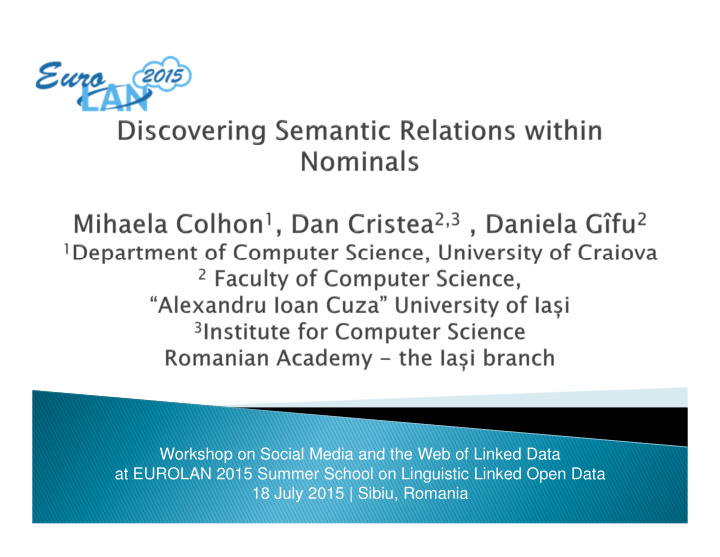



Workshop on Social Media and the Web of Linked Data at EUROLAN 2015 Summer School on Linguistic Linked Open Data 18 July 2015 | Sibiu, Romania
This work continues the research began in 2013, having the main scope of building a corpus of annotated entities and semantic relations. The used text is the Romanian version of the novel novel novel novel “ Quo Quo Vadis Quo Quo Vadis Vadis ”, authored by the Nobel Vadis laureate Henryk Henryk Henryk Henryk Sienkiewicz Sienkiewicz. Sienkiewicz Sienkiewicz The corpus is manually annotated with 12 types of anaphoric relations (e.g. coref , member-of , part-of , has-as-part ) and almost 30 types of non-anaphoric relations (e.g. parent-of , child- of , love , friendship , hate , superior-of , inferior- of , colleague-of ).
Entities are realized in texts as noun noun noun noun phrases phrases phrases phrases (NP NP NP) whose heads are nouns or pronouns . NP
Entities in QuoVadis corpus represent descriptions of persons, gods and any grouping of them.
� Anaphoric (noted REFERENTIAL) relations: coreferential, isa, class-of, member-of, has-as-member, part-of, has-as-part , etc. � Affectional (noted AFFECT) relations: friend-of, fear-of, love, loved-by, hate, hated-by, worship, worshiped-by, etc. � Kinship (noted KINSHIP) relations: parent-of, child-of, sibling-of, spouse-of, unknown, etc. � Social (noted SOCIAL) relations: superior-of, inferior-of, colleague-of, in- competition-with, etc.
Figure taken from A.-D. Bibiri, M. Colhon, P. Diac, D. Cristea (2014). Statistics Over A Corpus Of Semantic Links: “QuoVadis”. In M. Colhon, A. Iftene, V. Barbu Mititelu, D. Cristea, D. Tufiş (eds.) Proceedings of the 10th International Conference "Linguistic Resources And Tools For Processing The Romanian Language” , „Alexandru Ioan Cuza” University Publishing House, pag. 33-44
The colours code: colleague-of in-cooperation- with in-competition- with opposite-to inferior-of superior-of Figure taken from M. Colhon, P. Diac, C. Mărănduc, A. Perez, "QuoVadis" Research Areas – Text Analysis. In M. Colhon, A. Iftene, V. Barbu Mititelu, D. Cristea, D. Tufiş (eds.) Proceedings of the 10th International Conference "Linguistic Resources And Tools For Processing The Romanian Language”, „Alexandru Ioan Cuza” University Publishing House, pag. 45-56
HEAD HEAD HEAD [un grup de [ ]] mame cu [ ] in brate copii KINSHIP.parent-of REFERENTIAL.part-of [a group of [ ]] mothers with [ ] in their arms children Properties: Properties: Properties: Properties: - Imbricated entities have always separate heads. - There are not entities that intersect and which are non-imbricated. - The direction of the relation is from the larger entity (FROM entity) to the nested entity (TO entity)
Manual annotations include: Relation type: Relation type Relation type Relation type AFFECT.love � the relation’s span FROM entity: FROM entity FROM entity FROM entity � the relation type 1:[Ligia] TO entity TO entity TO entity TO entity: � the two entities 2:[familia lui Plautius] Trigger Trigger: Trigger Trigger � the trigger <iubită> relation’s span < < < < > > 1:[ 1:[ 1:[ 1:[ iubită este Ligia de familia lui Plautius > > ] ] 2:[ 2:[ ] ] ] ] 2:[ 2:[ ] ] > > > > < < 2:[ 2:[ 2:[ 2:[ < < dear Ligia was to Plautius 1:[ 1:[ ] ] 1:[ 1:[ ] ] ] ] ] ]
Our study: � addresses only to imbricated entities � uses lexical and syntactical patterns
� no lexical information is considered here � the main scope is to generalize the syntactic patterns found in the training corpus under the same relation realization � applied on the following relations: ◦ REFERENTIAL. has-as-member ◦ REFERENTIAL. has-as-part ◦ REFERENTIAL. has-as-subgroup
1:[ 2:[împăratul însui], , , , i i 3:[preoii], i i i i 4:[vestalele], i i , , , i i i i 5:[senatorii], , , , i i i i 6:[cavalerii], , , , i i i 7:[poporul]] i 1:[ 2:[împăratul însui], i 3:[preoii], i 4:[vestalele], i 5:[senatorii], i 6:[cavalerii], i 7:[poporul]] 1:[ 2:[Caesar himself] , , ,3:[priests] , , , , 4:[vestals] , , , , , 5:[senators] , , , 6:[knights] , , , 7:[the populace]] , , 1:[ 2:[Caesar himself], 3:[priests], 4:[vestals], 5:[senators], 6:[knights], 7:[the populace]] 1:[2:[Ncmsry Dh3ms] COMMA Cc COMMA Cc COMMA Cc COMMA Cc 3:[Ncmpry] COMMA Cc COMMA Cc COMMA Cc COMMA Cc 4:[Ncfpry] COMMA Cc COMMA Cc COMMA Cc 5:[Ncmpry] COMMA Cc COMMA Cc 6:[Ncmpry] COMMA Cc COMMA Cc COMMA Cc COMMA Cc COMMA Cc COMMA Cc COMMA Cc 7:[Ncmsry]] REFERENTIAL.has-as-member 1:[2:[ENTITY] COMMA Cc COMMA Cc COMMA Cc 3:[ENTITY] COMMA Cc COMMA Cc COMMA Cc 4:[ENTITY] COMMA Cc COMMA Cc COMMA Cc COMMA Cc COMMA Cc COMMA Cc 5:[ENTITY] COMMA Cc COMMA Cc COMMA Cc COMMA Cc 6:[ENTITY] COMMA Cc COMMA Cc 7:[ENTITY]] COMMA Cc COMMA Cc
1:[furtunos <urma> 2:[al consulilor]] 1:[mad <descendant> 2:[of consuls]] Relation type: KINSHIP.unknown triggered by <urma> dependency tree of the outer entity dependency tree of the inner entity
Relation type # test # correct Precision Recall F- relations measure AFFECT 3 3 1.0 1.0 1.0 KINSHIP 16 16 1.0 1.0 1.0 SOCIAL 20 15 1.0 0.75 0.86 REFERENTIAL 85 78 0.96 0.92 0.94 TOTAL 124 112 0.97 0.90 0.93
Recommend
More recommend